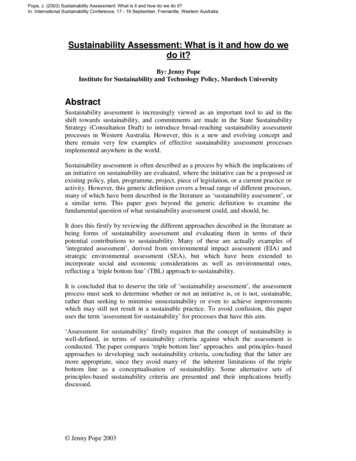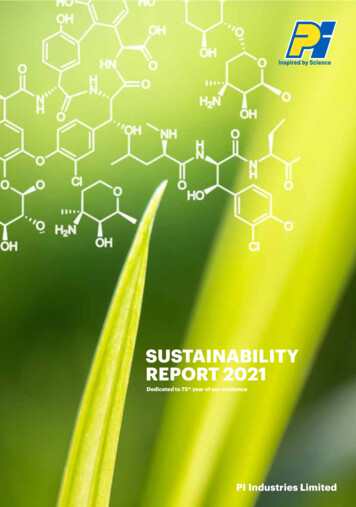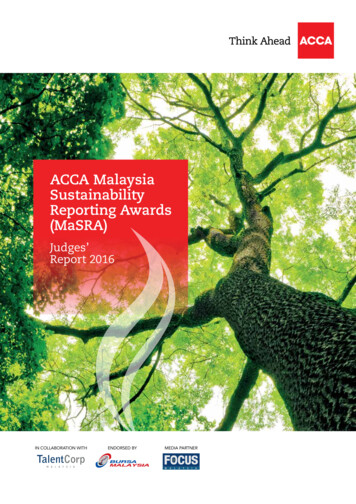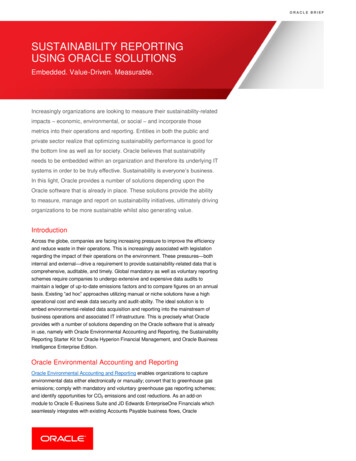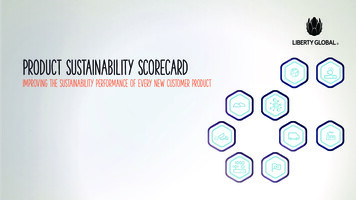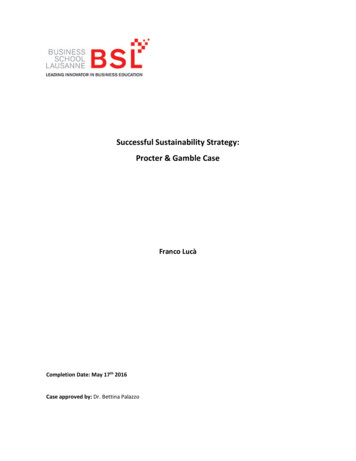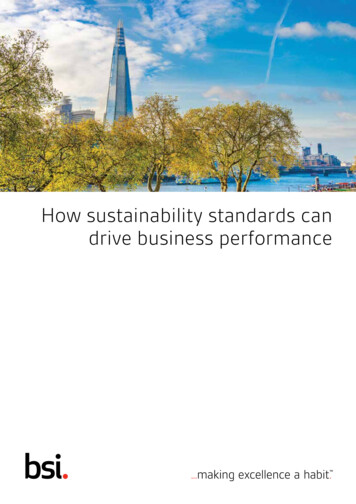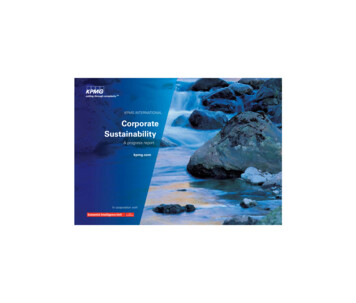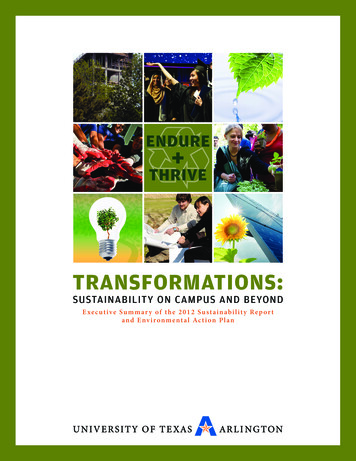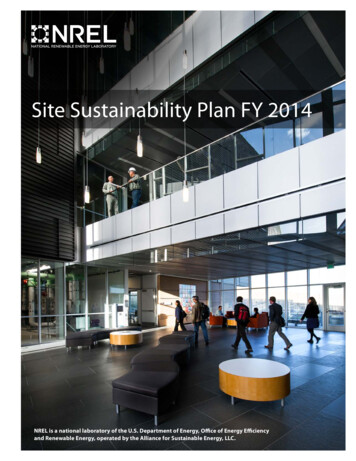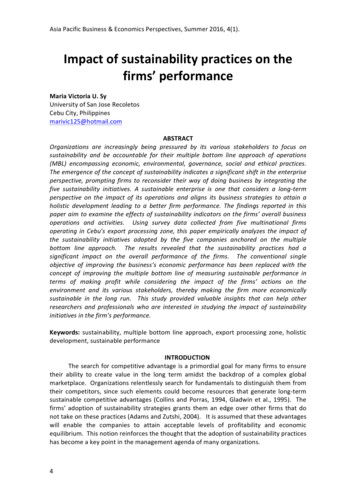
Transcription
Asia Pacific Business & Economics Perspectives, Summer 2016, 4(1).Impact of sustainability practices on thefirms’ performanceMaria Victoria U. SyUniversity of San Jose RecoletosCebu City, ions are increasingly being pressured by its various stakeholders to focus onsustainability and be accountable for their multiple bottom line approach of operations(MBL) encompassing economic, environmental, governance, social and ethical practices.The emergence of the concept of sustainability indicates a significant shift in the enterpriseperspective, prompting firms to reconsider their way of doing business by integrating thefive sustainability initiatives. A sustainable enterprise is one that considers a long-termperspective on the impact of its operations and aligns its business strategies to attain aholistic development leading to a better firm performance. The findings reported in thispaper aim to examine the effects of sustainability indicators on the firms’ overall businessoperations and activities. Using survey data collected from five multinational firmsoperating in Cebu’s export processing zone, this paper empirically analyzes the impact ofthe sustainability initiatives adopted by the five companies anchored on the multiplebottom line approach. The results revealed that the sustainability practices had asignificant impact on the overall performance of the firms. The conventional singleobjective of improving the business’s economic performance has been replaced with theconcept of improving the multiple bottom line of measuring sustainable performance interms of making profit while considering the impact of the firms’ actions on theenvironment and its various stakeholders, thereby making the firm more economicallysustainable in the long run. This study provided valuable insights that can help otherresearchers and professionals who are interested in studying the impact of sustainabilityinitiatives in the firm’s performance.Keywords: sustainability, multiple bottom line approach, export processing zone, holisticdevelopment, sustainable performanceINTRODUCTIONThe search for competitive advantage is a primordial goal for many firms to ensuretheir ability to create value in the long term amidst the backdrop of a complex globalmarketplace. Organizations relentlessly search for fundamentals to distinguish them fromtheir competitors, since such elements could become resources that generate long-termsustainable competitive advantages (Collins and Porras, 1994, Gladwin et al., 1995). Thefirms’ adoption of sustainability strategies grants them an edge over other firms that donot take on these practices (Adams and Zutshi, 2004). It is assumed that these advantageswill enable the companies to attain acceptable levels of profitability and economicequilibrium. This notion reinforces the thought that the adoption of sustainability practiceshas become a key point in the management agenda of many organizations.4
Asia Pacific Business & Economics Perspectives, Summer 2016, 4(1).At present, many business strategies are defined by the integration of concepts suchas management quality, environmental management, brand reputation, corporate ethicsand talent retention. Such perceptions are derived from the practices of creating economicvalue, increasing public wealth with adequate mechanisms for its distribution, socialjustification, environmentally sound activities, operations which are ethically conductedand procedures that conform to all applicable laws, rules and regulations. These measuresare deemed to be effective sustainable approaches paving the way for better corporatemanagement and thus performance (Orlitzky, et al., 2003).The sustainability practices that the firms develop will facilitate the establishment ofbetter systems of internal control, decision-making and cost saving (Adams, 2002).Through the efficient management of resources, companies will be able to achieve longterm sustainable competitive advantage. From the firm’s perspective, sustainability can bedefined as meeting the needs of a firm’s direct and indirect stakeholders, withoutcompromising its ability to meet the needs of future stakeholders (Dyllick & Hockerts,2002). The concept of sustainability provides the context from which researchers canstudy the practices adopted to create value. Value formation refers to both achievingsufficient profit and to satisfying the requests of a diverse group of stakeholders (Lopez etal., 2007).Despite the fact that more companies seem to demonstrate an increasingcommitment to a more sustainable behavior, in many cases, this is still done simply as amere paid lip service of green washing. One significant reason for this corporate rhetoriccan be attributed to the fact that companies do not really know how they can integratesustainable practices into their operating processes and business strategies. More oftenthan not, corporate sustainability practices are pursued more by chance than with a clear,well designed approach. With this study, we deal with the issues at hand by formulatingtwo objectives: (1) to identify the various drivers of sustainability practices adopted bycompanies based on the multiple bottom line framework; and (2) to determine the impactof the sustainability practices in the overall organizational performance. The two prongedobjectives were addressed by ascertaining the sustainability oriented activities of thecompanies based on the multiple bottom line approach and measuring the outcomesbased on the key indicators denoted in the platform of determining organizationalperformance.An improved understanding of the link between sustainability oriented practices andorganizational performance does not only contribute to the recognition of the importanceof these concepts, but also add to the knowledge of measuring sustainability-orientedactivities. However, there are only a few empirical studies made on specific organizationalperformance outcomes in relation to the adoption of sustainability practices. Based on theforegoing, the researcher sought to derive pragmatic evidence which will reveal that theadoption of sustainability practices does in fact have a significant impact on the overallperformance of the firm and not only advances this contention from a theoreticalstandpoint. The intent of the study was to determine the link between performanceresults and sustainability practices in order to analyze how these practices affect companyfunctioning.Furthermore this study aimed to determine how sustainability practices can be bothdeveloped and supported. It is critical to uncover the antecedents that help companiesmaintain various sustainable practices over a long period of time to ensure a substantiveand continual growth in the realm of sustainable development.5
Asia Pacific Business & Economics Perspectives, Summer 2016, 4(1).OBJECTIVES OF THE STUDYOrganizations are increasingly predisposed to incorporate society’s expectations intotheir operations and strategies, not only to respond to rising pressures from variousstakeholders but also to consider opportunities for creating competitive advantage. To thisend, this study seeks to identify those factors with the possibility for facilitating effectiveintegration of sustainability into corporate practices. The objectives of this research are: 1)to identify the various drivers of sustainability practices adopted by companies based onthe multiple bottom line framework; and 2) to determine the impact of the sustainabilitypractices on the overall organizational performance.FRAMEWORKBusiness sustainability has materialized as a central, multifaceted premise of thepresent time. Companies of all types and sizes are concentrating on business sustainabilityas a means of designing a continuing value for shareholders and managing the interests ofother stakeholders. Business sustainability is a method of facilitating the companies’capabilities to formulate and implement strategies that lead to the continuing performanceof the firm in all areas. The context of sustainability is not only intended to ensure longterm profitability and competitive advantage of the organization, but also contributes tothe improvement of the well being of societal members.This study is anchored on the premise of sustainable management by Aligleri (2011)who defined the concept as a “business approach that considers the pattern oforganization of ecosystems in the decision making processes and management practicescovering assessment indicators in the economic, environmental, ethical, governance andsocial dimensions.” This view implies that the management of sustainability is intended toenable gains for the firm, society and environment. A core aspect of the sustainabilitymanagement framework is the inclusion of stakeholders and the integration of theirrespective demands (Seuring and Gold, 2013), which is implied to be a critical process thatassists organizations in understanding their key environmental and social impacts (Rocha,et al., 2007).Sustainability management practices involve the “adoption of a long term focus anda more inclusive set of responsibilities” that have a beneficial effect on “the ecosystems,societies and environments of the future” (Ameer & Othman, 2012). The said practicespermit “long term value creation” by helping companies to “develop opportunities andmanage economic, environmental, ethical, governance and social risks” (Lopez et al.,2007). For many companies, developing sustainability practices to meet the stakeholders’various expectations has become crucial (Delgado-Ceballos, et al., 2011). Sustainabilitypractices represent a holistic, balanced and long-term approach to conducting businesswith potential to have a net positive impact on ecological, social, economic, and ethical,governance systems, and various stakeholders.There are three overriding principles of business sustainability practices. These arevalue creation, accountability assurance and performance enhancement (Brockett &Rezaee, 2013). The value creation principle suggests companies should create themaximum quantity of products and services with the least utilization of scare resources,while maintaining the highest quality and efficiency to generate the highest level ofcustomer satisfaction. A major objective of any firm is the creation of value for allstakeholders in the community. An accountability assurance principle means conducting6
Asia Pacific Business & Economics Perspectives, Summer 2016, 4(1).business in an ethical and socially responsible manner. A proper assurance processrequires timely and deliberate planning, aggressive actions, effective implementation,continuous monitoring and enforceable accountability. The performance enhancementprinciple indicates achievement of sustainable performance based on the five dimensions.This will pave the way of enhancing the firm’s positive impacts and mitigating negativeimplications on society and the environment.Recognizing the broad nature of sustainability, there is a growing range of specificsustainability practices being implemented by organizations (Hahn & Scheermesser, 2006).Due to this, there are various ways in conceptualizing and operationalizing sustainabilityconstructs. One of the most commonly used measures is derived from the multiple bottomline of economic, governance, environmental, ethical and social performance indicators.Figure 1. Drivers of sustainability frameworkEconomic vigor as a component of corporate sustainabilityEconomic vigor when operationalized as a component of sustainability entails abusiness approach that creates long term shareholder value by dealing with opportunitiesand managing risks arising from economic, social and environmental challenges (Wagner,2010).Creating shareholder value by ensuring continual sustainable economicperformance is a major challenge for many firms today. To incorporate sustainabilityprinciples into the companies’ business strategies and to make sound resource allocationdecisions, managers need to measure the link between social and environmental actionswith financial performance. Many companies are cognizant of the contribution of variousinvestments and economic decisions in sustainability initiatives to improve shareholdervalue and maximizing net gains to both the company and society.Epstein and Roy (2001) formulated a framework that organized the drivers ofcorporate sustainability and financial performance into five major areas. The frameworkstarts with corporate and business unit strategy and moves to the second component: thesustainability actions that will be used to implement strategies. Firms can analyze andinstitute the drivers of and causal relationships with the processes to sustainabilityperformance, stakeholder reactions and long term corporate financial performance. Thecorporate financial performance component of the framework then feeds back into thecorporate strategy to improve and challenge strategies and assumptions leading toimproved financial performance. The framework requires that firms implement adequatesystems, structures and performance mechanisms to enhance corporate financial andsustainability performance (Waddock & Graves, 1997).The systems, structures and measures provide a better understanding of theantecedents of economic performance and the effects of that performance on the various7
Asia Pacific Business & Economics Perspectives, Summer 2016, 4(1).stakeholders of the firm. This framework helps managers to better integrate sustainabilitytenets into their business strategies by setting relevant priorities and by evaluatingbusiness options. A salient feature of the framework is the difference betweenintermediate results and financial outcomes. Intermediate results, such as improvedsustainability performance (e.g. product safety) and positive stakeholder reaction (e.g.,customer satisfaction) must be observed to assess profit outcomes of sustainabilitypractices. The sustainability and financial health of the organization are importantdeterminants of keeping investor confidence high. This is in consonance with Freeman’sstakeholder theory (1984), which emphasized the notion that corporations haveresponsibilities to their stakeholders and other interest groups. Hence, the business casefor sustainability is understood to include strategic and profit driven response of thecompany to environment and social issues, which caused these entities to pursue primaryand secondary activities.Corporate governance as a dimension of corporate sustainabilityCorporations have traditionally been viewed as self-centered, profit maximizingentities comprising the central tenets of capitalism and free market doctrine (Hg, 2007).However, in the aftermath of a series of financial debacles that various economies haveexperienced brought about by the global financial crisis, countries have taken initiatives toimprove their corporate governance policies by establishing more robust measures tostrengthen their regulatory frameworks in order to promote economic stability, public trustand investor confidence. Various measures are undertaken to enable the convergence of aset of globally accepted corporate governance practices and the integration of businesssustainability into corporate governance. These developments have once again redirectedinterest to issues of good governance, trust and accountability, intensifying the discussionon topics of corporate governance (CG) and the ethics of economic conduct (Marsiglia &Falautano, 2005).While shareholder value maximization is still a primary goal for businessorganizations worldwide, the rise in social activism and the emergence of new expectationshave given rise to other aspects of corporate performance to be scrutinized alongsidefinancial results. As firms expand, they are not just plain movers of economic growth, butmost importantly, to balance multiple bottom-lines and manage the interests of multiplestakeholders (Jamali, 2006). This is where the concept of corporate governance comes in.Based on this premise, organizations are expected to realize gains while maintaining thehighest standards of governance internally.Cadbury (2000) defined corporate governance as “the system by which companiesare directed and controlled.” The control aspect of corporate governance (CG) includes thenotions of compliance, accountability and transparency (MacMillan et al., 2004), and howmanagers exert their functions through compliance with existing laws, regulations andcodes of conduct (Cadbury, 2000). The importance of CG lies in its pursuit at continualrefinement of the laws, regulations and contracts that govern companies’ activities whileensuring that shareholder rights are protected, stakeholder and manager/executiveconcerns are reconciled, and that a transparent environment is maintained. Transparencyprinciple calls for a culture where each stakeholder is able to perform his tasks andresponsibilities leading to the firm’s growth and value creation (Page, 2005). Corporategovernance sets the springboard in defining as to how power is exerted and decisions aremade in an organization.8
Asia Pacific Business & Economics Perspectives, Summer 2016, 4(1).The Professional Accountants in Business (PAIB) and the Committee of theInternational Federation of Accountants (IFAC) in 2009 defined Corporate Governance (CG)as “the set of responsibilities and practices exercised by the board and executivemanagement (the governing body) with the goal of: a) providing strategic decision, b)ensuring that objectives are achieved, c) ascertaining that risks are managed appropriately,and d) verifying that the organization’s resources are used responsibly.” In this concept,corporate governance encompasses both the conformance and performance aspects. Theconformance aspect of CG reflects compliance with all applicable laws, rules, regulationsand standards, as well as accountability to all stakeholders. The performance aspect of CGemphasizes the importance of policies and procedures in addressing opportunities andrisks, best practices, resource utilization, strategy, value creation and decision-making. Insummary, CG revolves around a set of universal attributes, including ensuringaccountability to shareholders and other stakeholders (Keasy & Wright, 1997), creatingmechanisms to control managerial behavior (Tricker, 1994) and ensuring that companiesare run according to the laws and answerable to all stakeholders (Dunlop, 1998).Social dimension of corporate sustainabilityCorporations have modified their key goals from profit maximization to creatingvalue for all stakeholders, including shareholders, while at the same time fulfilling theirsocial responsibilities. This is attributed to the fact that investors are diversifying theirportfolios by putting their money in firms committed to the concept of corporatesustainability. Investors are drawn to this venture style as it promises the creation of longterm shareholder value by welcoming opportunities and dealing with risks arising fromongoing economic, environmental and social developments. The social dimension ofcorporate sustainability is anchored on the premise that companies can contribute to thesocial well being of communities by interacting with its various stakeholders andaddressing to their specific and evolving needs leading to securing a long term “license tooperate” and excellent customer and employee loyalty (Knoepel, 2001).Social performance practices to support corporate sustainability measure howwell an organization has translated its social goals into practice. It is assessed in terms ofthe principles, actions and measures adopted. The social dimension of corporatesustainability involves making an organization’s social mission a reality, aligned with theinterests of society by integrating acceptable social values and fulfilling social responsibility(Brockett & Rezaee, 2012). The social dimension of corporate sustainability challengesorganizations to adhere to the basic tenet of doing good which is more than the so-called“business as usual philosophy.” It entails aligning the company’s values, interests,decisions and processes with those of its stakeholders. The social aspect of sustainabilityencourages firms to take the necessary initiatives to advance social good beyond their ownvested interests and compliance with the legal requirements.Social performance practices can respond effectively to societal and stakeholderdemands by embedding social considerations into business operations and strategies andmust be pursued voluntarily. Social dimension of corporate sustainability includes threecomponents: (1) identification of an organization’s social responsibility domains; (2)corporate malfeasances and unethical behavior, and (3) implementation of programs tomanage social issues (McKnight, 2011). Organizations can no longer separate theiractivities from the wider society and environment in which they operate. Hence, they needto effectively measure their social performance to maintain their sustainability. Social9
Asia Pacific Business & Economics Perspectives, Summer 2016, 4(1).sustainability of an organization refers to the consciousness of responsibility for its ownactions as well as an authentic and credible commitment (normally long term) in allbusiness activities.Ethical dimension of corporate sustainabilityThe interdependence among society, environment and economic development arefundamental to the concept of sustainability. To achieve sustainable development, peoplecharacterize the interactions among these three “pillars of sustainability.” This is becausecreating symmetry among the pillars cannot be attained without a clear understanding ofhow societal and industrial activities affect the environment or may impact futuregenerations. Hence, there is a need to determine the issues affecting sustainabledevelopment. Practices geared towards attaining sustainability are rooted on the notionthat mankind needs to use natural resources responsibly with diminishing the quality of lifedue to losses in future economic opportunities or to negative impacts on social conditions,human health and environment (Enderle, 1999). This hypothesis makes it clear that themetrics of performance must be articulated to assess the efficacy of the outcome of anydecision concerning sustainability.It is a common practice for business managers/executives to address the economicpillar of sustainability first and foremost. The pillar associated with ethics as a dimensionof sustainability is often overlooked. The philosophy of sustainable developmentemphasizes the supremacy of values characteristic to all people and businesses manifestedthrough ethical deeds. The ethical dimension of corporate sustainability encompasses aset of moral principles, best practices and standards that guide business behavior. It refersto an entity’s collective values, which can be used to assess whether the behavior of thecollective members of the organization is adequate (Rezaee, 2008). Furthermore, theethical aspect of sustainability aims to determine whether the business is held accountablefor its openness, integrity and behavior.Considering that laws are not adequate to regulate and monitor the organization’sactivities, ethical practices are upheld to include those actions that are expected orprohibited by societal members even though they are not codified into law. Ethicalpractices represent the full scope of norms, standards, and expectations that reflect whatsocietal stakeholders perceive as fair, just and in keeping with the respect or protection oftheir moral rights (Carroll & Buchholtz, 2006). Ideal business ethical practices as acomponent of corporate sustainability will foster ethical objectives, which include but arenot limited to adherence to moral principles, trust and integrity and managing theenterprise based on the rules of openness, mutual respect and accountability.Environmental dimension of corporate sustainabilityIncreasing societal concern about the condition of the Earth’s ecosystems has set offindustry and business leaders to manage in new ways by becoming more proactive in theirresponse to environmental issues. The need for environmental sustainability arose fromthe acknowledgment that the wasteful, decadent and inequitable nature of currentpatterns of development, when projected in the future leads to biophysical impossibilities(Beckerman, 1994). Within the context of environmental sustainability, it is possible toalter the growth trends and establish a condition of ecological and economic stability thatis sustainable into the future. Sustainability is essentially the relationship between theenvironment and society. The 1987 Brundtland Commission concluded that sustainable10
Asia Pacific Business & Economics Perspectives, Summer 2016, 4(1).development must integrate environmental concerns into the mainstream policies oforganizations.Environmental sustainability is understood as the “maintenance of natural capital”comprising of input and output. Environmental sustainability in itself seeks to improvehuman welfare by protecting the sources of raw materials used for human needs andensuring that the sinks for human wastes are not exceeded, in order to prevent harm tohumans (Goodland, 1995). The philosophy of environmental sustainability involvesecosystem integrity, carrying capacity and biodiversity. It requires that natural capital bemaintained as a source of economic inputs and as a sink for wastes. It implies thatresources must be harvested no faster than they can be regenerated. Wastes must beemitted no faster than they can be assimilated by the environment (Kahn, 1995).An environmentally sustainable organization is a business that operates in a waythat is consistent with the principle of sustainable development. This means that the firmwill conduct its operations in way that will not use up natural resources any faster thanthey can be replenished, make and transport products efficiently with minimal use ofenergy and design products which when worn out could be disassembled and recycled(Lawrence and Weber, 2006). Adherence to the notion of environmental sustainabilityrequires companies to undergo three distinct phases in the development of greenmanagement practices. The first stage is pollution prevention, which focuses onminimizing or eliminating waste before it is created. The second phase is productstewardship. In this part, managers concentrate on all environmental impacts associatedwith the full life cycle of a product from the design of the commodity to its final use anddisposal. The third and most important segment is the adoption of clean technology.Organizations develop innovative new technologies in this part that support sustainability(Dunphy, et al., 2003).Organizational PerformanceThe concept of organizational performance refers normally to financial aspects suchas profit, return on assets, return on equity and economic value added (EVA). Whilefinancial measures of performance are among the most widely used by organizations, thereare other more balanced methods of performance measurement systems which includeboth financial and non financial performance determinants providing better perspectives interms of links between performance systems and organizational strategy (Neely andAdams, 2000).The key to developing a framework to improve organizational performanceanchored on the multiple bottom line approach is to construct performance measures thatare properly integrated and directed towards achieving organizational goals and strategies.Aside from using the traditional measures of assessing company performance, Gomes, etal., (2011) suggested that organizations should also consider using softer performanceparameters such as social responsibility. Based on corporate social performance andcorporate financial performance, Fauzi, et al., (2010) proposed a multi dimensional bottomline as sustainable corporate performance indicators. The key in developing a sustainableorganization is to construct the multiple organizational performance measures so that theyare properly integrated and directed towards achieving organizational goals and objectives.In conclusion, all organizations – regardless of size, industry or location – stand tobenefit from business sustainability practices, initiatives and strategies by enhancing theireconomic, governance, social, environmental and ethical performance. This business11
Asia Pacific Business & Economics Perspectives, Summer 2016, 4(1).sustainability framework focuses on strategic decisions that create sustainable shareholdervalue while managing and protecting the interests of a broader range of stakeholders.METHODOLOGYThe study adopted the quantitative method of research specifically the descriptivenormative survey. Surveying the firms using the descriptive method was deemed as mostappropriate in determining the managerial perceptions on the sustainability constructsused in this study. The study employed novel constructs, which transcended beyond thetri-focal approach of the sustainability framework involving social equity, economicperformance and environmental management. The current research included two moreantecedents, namely corporate governance and ethics. The basic theme for this study wasto examine the precursor/s of organizational activities anchored on the multiple bottomline concept of sustainability. Aside from determining the drivers of sustainability practices,the study likewise was designed to gauge the impact of these practices in the overallperformance of the companies. In so doing, the respondent firms were asked to measurethe extent to which the practices have contributed to the attainment of their corporateobjectives through a simple method of computing the summary mean for five relatedparameters. Although the constructs were categorized into five m
Epstein and Roy (2001) formulated a framework that organized the drivers of corporate sustainability and financial performance into five major areas. The framework starts with corporate and business unit strategy and moves to the second component: the sustainability actions that will be used to implement strategies. Firms can analyze and
